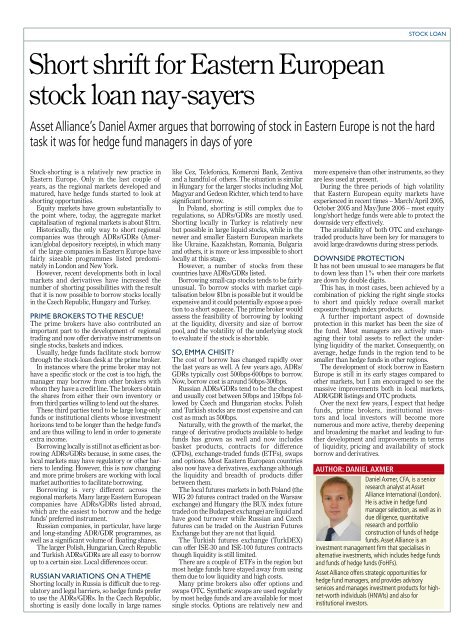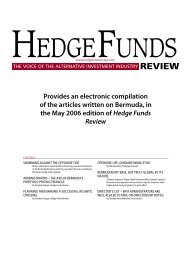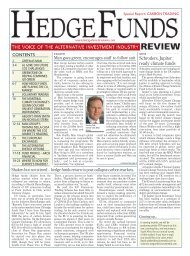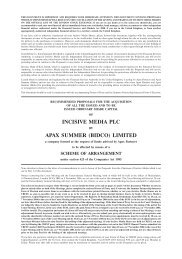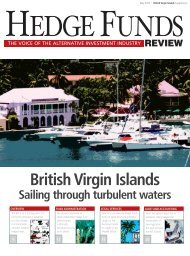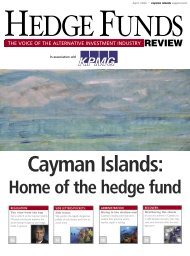RTS plans raft of new derivatives - Incisive Media
RTS plans raft of new derivatives - Incisive Media
RTS plans raft of new derivatives - Incisive Media
You also want an ePaper? Increase the reach of your titles
YUMPU automatically turns print PDFs into web optimized ePapers that Google loves.
Short shrift for Eastern Europeanstock loan nay-sayersstock loanAsset Alliance’s Daniel Axmer argues that borrowing <strong>of</strong> stock in Eastern Europe is not the hardtask it was for hedge fund managers in days <strong>of</strong> yoreStock-shorting is a relatively <strong>new</strong> practice inEastern Europe. Only in the last couple <strong>of</strong>years, as the regional markets developed andmatured, have hedge funds started to look atshorting opportunities.Equity markets have grown substantially tothe point where, today, the aggregate marketcapitalisation <strong>of</strong> regional markets is about $1trn.Historically, the only way to short regionalcompanies was through ADRs/GDRs (American/globaldepository receipts), in which many<strong>of</strong> the large companies in Eastern Europe havefairly sizeable programmes listed predominatelyin London and New York.However, recent developments both in localmarkets and <strong>derivatives</strong> have increased thenumber <strong>of</strong> shorting possibilities with the resultthat it is now possible to borrow stocks locallyin the Czech Republic, Hungary and Turkey.prime brokers to the rescue!The prime brokers have also contributed animportant part to the development <strong>of</strong> regionaltrading and now <strong>of</strong>fer derivative instruments onsingle stocks, baskets and indices.Usually, hedge funds facilitate stock borrowthrough the stock-loan desk at the prime broker.In instances where the prime broker may nothave a specific stock or the cost is too high, themanager may borrow from other brokers withwhom they have a credit line. The brokers obtainthe shares from either their own inventory orfrom third parties willing to lend out the shares.These third parties tend to be large long-onlyfunds or institutional clients whose investmenthorizons tend to be longer than the hedge fund’sand are thus willing to lend in order to generateextra income.Borrowing locally is still not as efficient as borrowingADRs/GDRs because, in some cases, thelocal markets may have regulatory or other barriersto lending. However, this is now changingand more prime brokers are working with localmarket authorities to facilitate borrowing.Borrowing is very different across theregional markets. Many large Eastern Europeancompanies have ADRs/GDRs listed abroad,which are the easiest to borrow and the hedgefunds’ preferred instrument.Russian companies, in particular, have largeand long-standing ADR/GDR programmes, aswell as a significant volume <strong>of</strong> floating shares.The larger Polish, Hungarian, Czech Republicand Turkish ADRs/GDRs are all easy to borrowup to a certain size. Local differences occur.russian variations on a themeShorting locally in Russia is difficult due to regulatoryand legal barriers, so hedge funds preferto use the ADRs/GDRs. In the Czech Republic,shorting is easily done locally in large nameslike Cez, Telefonica, Komercni Bank, Zentivaand a handful <strong>of</strong> others. The situation is similarin Hungary for the larger stocks including Mol,Magyar and Gedeon Richter, which tend to havesignificant borrow.In Poland, shorting is still complex due toregulations, so ADRs/GDRs are mostly used.Shorting locally in Turkey is relatively <strong>new</strong>but possible in large liquid stocks, while in the<strong>new</strong>er and smaller Eastern European marketslike Ukraine, Kazakhstan, Romania, Bulgariaand others, it is more or less impossible to shortlocally at this stage.However, a number <strong>of</strong> stocks from thesecountries have ADRs/GDRs listed.Borrowing small-cap stocks tends to be fairlyunusual. To borrow stocks with market capitalisationbelow $1bn is possible but it would beexpensive and it could potentially expose a positionto a short squeeze. The prime broker wouldassess the feasibility <strong>of</strong> borrowing by lookingat the liquidity, diversity and size <strong>of</strong> borrowpool, and the volatility <strong>of</strong> the underlying stockto evaluate if the stock is shortable.so, emma chisit?The cost <strong>of</strong> borrow has changed rapidly overthe last years as well. A few years ago, ADRs/GDRs typically cost 500bps-600bps to borrow.Now, borrow cost is around 50bps-300bps.Russian ADRs/GDRs tend to be the cheapestand usually cost between 50bps and 150bps followedby Czech and Hungarian stocks. Polishand Turkish stocks are most expensive and cancost as much as 500bps.Naturally, with the growth <strong>of</strong> the market, therange <strong>of</strong> derivative products available to hedgefunds has grown as well and now includesbasket products, contracts for difference(CFDs), exchange-traded funds (ETFs), swapsand options. Most Eastern European countriesalso now have a <strong>derivatives</strong>, exchange althoughthe liquidity and breadth <strong>of</strong> products differbetween them.The local futures markets in both Poland (theWIG 20 futures contract traded on the Warsawexchange) and Hungary (the BUX index futuretraded on the Budapest exchange) are liquid andhave good turnover while Russian and Czechfutures can be traded on the Austrian FuturesExchange but they are not that liquid.The Turkish futures exchange (TurkDEX)can <strong>of</strong>fer ISE-30 and ISE-100 futures contractsthough liquidity is still limited.There are a couple <strong>of</strong> ETFs in the region butmost hedge funds have stayed away from usingthem due to low liquidity and high costs.Many prime brokers also <strong>of</strong>fer options andswaps OTC. Synthetic swaps are used regularlyby most hedge funds and are available for mostsingle stocks. Options are relatively <strong>new</strong> andmore expensive than other instruments, so theyare less used at present.During the three periods <strong>of</strong> high volatilitythat Eastern European equity markets haveexperienced in recent times – March/April 2005,October 2005 and May/June 2006 – most equitylong/short hedge funds were able to protect thedownside very effectively.The availability <strong>of</strong> both OTC and exchangetradedproducts have been key for managers toavoid large drawdowns during stress periods.downside protectionIt has not been unusual to see managers be flatto down less than 1% when their core marketsare down by double digits.This has, in most cases, been achieved by acombination <strong>of</strong> picking the right single stocksto short and quickly reduce overall marketexposure though index products.A further important aspect <strong>of</strong> downsideprotection in this market has been the size <strong>of</strong>the fund. Most managers are actively managingtheir total assets to reflect the underlyingliquidity <strong>of</strong> the market. Consequently, onaverage, hedge funds in the region tend to besmaller than hedge funds in other regions.The development <strong>of</strong> stock borrow in EasternEurope is still in its early stages compared toother markets, but I am encouraged to see themassive improvements both in local markets,ADR/GDR listings and OTC products.Over the next few years, I expect that hedgefunds, prime brokers, institutional investorsand local investors will become morenumerous and more active, thereby deepeningand broadening the market and leading to furtherdevelopment and improvements in terms<strong>of</strong> liquidity, pricing and availability <strong>of</strong> stockborrow and <strong>derivatives</strong>.author: daniel axmerDaniel Axmer, CFA, is a seniorresearch analyst at AssetAlliance International (London).He is active in hedge fundmanager selection, as well as indue diligence, quantitativeresearch and portfolioconstruction <strong>of</strong> funds <strong>of</strong> hedgefunds. Asset Alliance is aninvestment management firm that specialises inalternative investments, which includes hedge fundsand funds <strong>of</strong> hedge funds (FoHFs).Asset Alliance <strong>of</strong>fers strategic opportunities forhedge fund managers, and provides advisoryservices and manages investment products for highnet-worthindividuals (HNWIs) and also forinstitutional investors.


